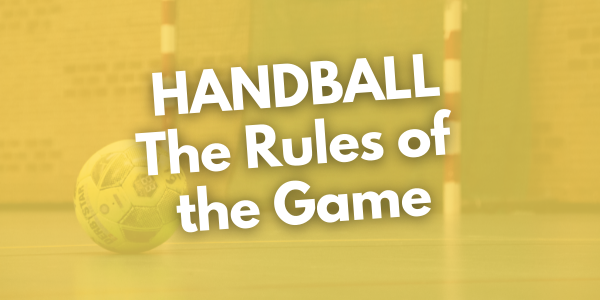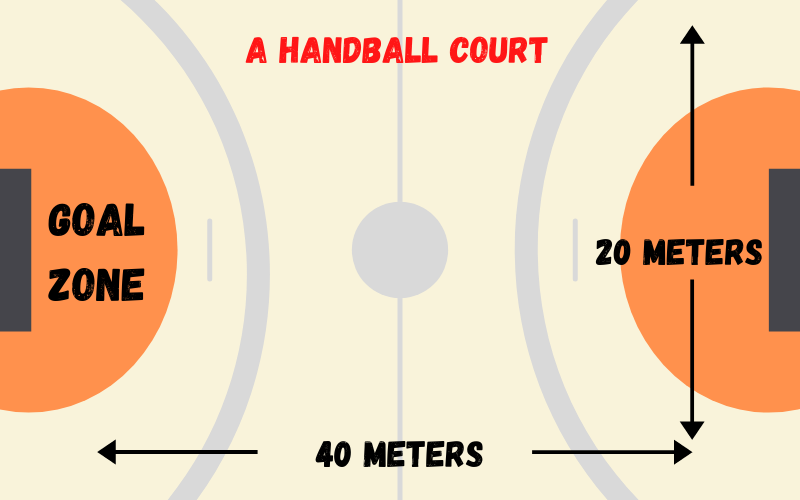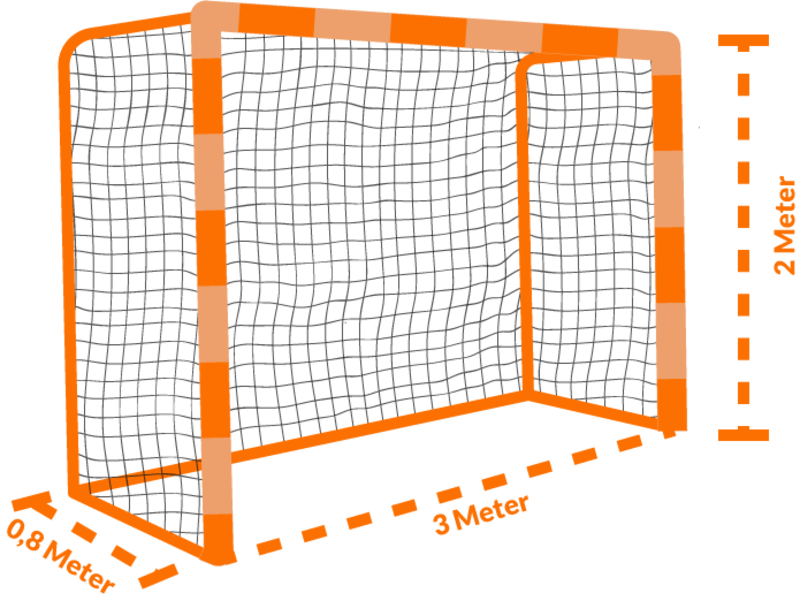Handball Rules for Beginners: How to Play Handball

Handball is primarily an indoor sport played between 2 teams competing to see which can score the most goals in the allotted time.
Handball is the second most popular sport in Europe. Although it’s mostly played indoors, a variation of the game takes place on a sandy beach. Beach handballs and indoor handball rules are nearly identical. We will point out any variations throughout this guide.
Here is a downloadable PDF of all the rules you’re going to find on this page!
The Teams
Handball teams start the game with 7 players on the court, 1 goalkeeper, and 6 outfield players. Each team can have up to 7 reserve players on the bench.
The positions are called:
- Goalkeeper
- Left Back
- Center Back or Center
- Right Back
- Left Winger
- Center Forward or Pivot, also knows as Circle Runner
- Right Winger
Goalkeepers play in their own goal zone and protect against shots coming from the opposing team.
Left and right backs use their size to clog up passing lanes.
Centers communicate strategies between players.
Wingers use their speed along the outsides of the court. Forwards, also know as pivots or circle runners, get to take the most shots.
The Court
The dimensions of a handball court are always 40 meters x 20 meters, or 131 feet by 65 feet, with two goals set up at each end.
Players must never enter the goal zone. If they do, their team loses possession of the ball and their opponent’s goalkeeper restarts the game with a pass.
Within the goal zone, the goalkeeper can use any part of their body to blocks shots and prevent the opposing team from scoring.

The dimensions of the goal are 3 meters by 2 meters with a 0.8-meter depth, or 10 feet by 6.5 feet with a 2.5-foot depth.

After a ceremonial coin toss, to decide the first possession, the game starts with a throw-off.
During a throw-off, a player in the middle of the court passes the ball back to a teammate to begin the game.
A throw-off takes place at the start of both halves of the game and after every goal.
How to Score in Handball?
The point of the game is to score as many goals as possible. Whichever team scores the most, wins.
To score in handball, a player must throw the ball in between the other team’s goalposts.
- The shot must come from outside of the 6-meter line, and the entire ball must pass the goal line for a point to be awarded.
- A point in handball is called a goal.
- Attacking players are allowed to jump into, or land in, the goal area as long as they released the ball before they land.
- Goals can be scored from free throws, throw-ins, throw-offs, and goal throws as long as the shot comes from outside of the 6-meter line.
- It’s completely normal for a player to throw the ball directly into the net, bounce it off the court, or deflect it off a post.
- You’re not allowed to use any part of your body below the knee.
Handball Gameplay Rules
- Players holding the ball can take 3 steps before they must pass or shoot the ball.
- Taking more than 3 steps results in a turnover.
- Players without the ball can move around freely without having to count their steps.
- Players can hold the ball for a maximum of 3 seconds before they must shoot, pass, or dribble.
- Holding the ball for longer than 3 seconds results in a turnover. Players can dribble (bounce the ball) once to reset the 3-second to take 3 more steps, shoot, or pass.
Passive Play Rule
To make the game attractive for the players and the audience a passive play rule was created. It allows the referee to force the team holding on to the ball to be more aggressive and take a shot.
When a referee notices a team passing the ball back and forth without the intention of attacking, they will raise their hand to signal the team for a passive play foul.
Once a referee raises their hand, the team with possession has 6 passes left before they must take a shot. The shot does not count as one of the passes.
A foul, free-throw, or throw-in do not reset the 6 pass limit once passive play has been signaled.
Only a shot cancels out the passive play penalty.
If the team doesn’t take a shot, they forfeit possession and the game restarts with a free throw from where the 7th pass was made.
How Long is a Game of Handball?
The referee or match official should have a stopwatch ready at the beginning of the game to start the time during the first throw-off.
- A game of handball lasts 60 minutes.
- Two 30-minute halves are divided by a 10-minute intermission.
- A tie leads to a 10-minute overtime period which consists of two 5-minute halves with a 1-minute break in between.
- If the game remains tied, a second 10-minute overtime period is played, followed by a penalty shootout.
In handball, the game clock doesn’t stop for when a goal is scored. It keeps running during any event that can be considered a part of the game.
Time keeps going during these events:
- When a goal is scored
- During a substitution
- When the ball goes out of bounds
- During a free-throw
- During a penalty shot
The time stops when:
- Either coach uses a time-out.
- A player has been shown a card, has been suspended, or has been disqualified.
- When the referee blows the whistle to pause the game for miscellaneous reasons.
Handball Fouls
Any unnecessary physical behavior is considered a foul. Goalkeepers using their hands outside of their goal zone is also a foul.
A referee will use a whistle to stop a game of handball once a foul is committed and decide if the infringement is punishment-worthy.
The referee will choose to punish the perpetrator with a warning, a 2-minute suspension, or dismissal from the game based on the severity of the foul.
Handball referees use 3 different cards to categorize fouls and infringements. Yellow, red, and blue. Any card can be shown to a player or a coach.
- Yellow cards are a warning often awarded to players who have kicked the ball or inadvertently charged into an opponent.
- Red cards are given to players for severe fouls such as tripping or unnecessary outbursts of violent physicality. A player or a coach receiving a red card is disqualified from the game.
- Players or coaches shown a blue card are disqualified and suspended for multiple subsequent games. Blue cards are mostly only awarded for fighting or verbally assaulting a referee. Blue cards are only common in professional leagues and the Olympic Games.
For common fouls, such as kicking the ball, the game will restart with a free throw. If a foul denies a clear goal-scoring opportunity, the referee can award a penalty shot.
Handball Penalty Shots
If a player is fouled attempting to score a goal, the referee will almost certainly award a penalty shot. Penalty shots in handball are called only for taking away a clear goal-scoring opportunity. Handball penalty shots are often called a 7-meter throw since they come from 7 meters away from the net.
- The shooter stands at the 7-meter line to take the penalty shot.
- The shooter’s feet cannot cross or touch the line until the ball leaves their hand.
- During a penalty shot, one of the shooter’s feet needs to be planted on the floor the entire time. Jumping is not allowed.
- The shot needs to be taken within 3 seconds after the referee’s whistle.
- The defending team can choose to substitute the goalkeeper for a penalty shot.
- Every player, except the shooter and the goalie, needs to stand behind the free-throw line as the penalty shot is being taken.
- If a player on the shooter’s team crosses the free-throw line before the ball leaves the shooter’s hand, the penalty is forfeit and the goalkeeper’s team receives a free throw.
- If any player on the goalkeeper’s team goes over the free-throw line before the ball leaves the shooter’s hand, the penalty shot is retaken. Unless the shooter scores.
Different Types of Throws in Handball
Free Throw
- Free throws are a result of a foul or a rule violation.
- Often called a 3-meter throw because the opposing team players must be at least 3 meters from where the free throw is taken from.
- Free throws are taken from where the foul or violation happened.
- Free throws can not be taken from the goal zone.
- Simple fouls, too many steps, kick-ball, and passive play result in a free throw.
Throw-In
- Throw-ins take place when the ball goes out of play on the sideline.
- The ball is awarded to the team that didn’t touch the ball last.
- A player throwing the ball back into play must keep at least one foot on the sideline while attempting to pass to a teammate or shoot a goal.
- Deflections, blocked shots, and bad passes are the most common reasons for a throw-in.
Goal Throw
- Made by the goalkeeper standing in their goal zone to a player outside of it.
- Goal throws resume the game when the ball goes out of play behind a goalkeeper’s net.
- If an attacking player enters the goal zone, their team forfeits possession, and the game restarts with a goal throw.
Here is a downloadable PDF of all the rules you’re going to find on this page!




